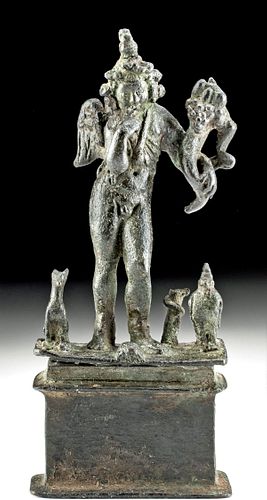Roman-Egyptian Bronze Pantheistic Harpokrates, ex-Kluge
Lot 15
About Seller
Artemis Fine Arts
686 S Taylor Ave, Ste 106
Louisville, CO 80027
United States
Selling antiquities, ancient and ethnographic art online since 1993, Artemis Gallery specializes in Classical Antiquities (Egyptian, Greek, Roman, Near Eastern), Asian, Pre-Columbian, African / Tribal / Oceanographic art. Our extensive inventory includes pottery, stone, metal, wood, glass and textil...Read more
Estimate:
$12,000 - $18,000
Absentee vs Live bid
Two ways to bid:
- Leave a max absentee bid and the platform will bid on your behalf up to your maximum bid during the live auction.
- Bid live during the auction and your bids will be submitted real-time to the auctioneer.
Bid Increments
| Price | Bid Increment |
|---|---|
| $0 | $25 |
| $300 | $50 |
| $1,000 | $100 |
| $2,000 | $250 |
| $5,000 | $500 |
| $10,000 | $1,000 |
| $20,000 | $2,500 |
| $50,000 | $5,000 |
| $100,000 | $10,000 |
| $200,000 | $20,000 |
About Auction
By Artemis Fine Arts
Oct 8, 2020
Set Reminder
2020-10-08 10:00:00
2020-10-08 10:00:00
America/New_York
Bidsquare
Bidsquare : Exceptional Antiquities, Asian, Ethnographic
https://www.bidsquare.com/auctions/artemis-gallery/exceptional-antiquities-asian-ethnographic-5796
Museum-worthy examples of Egyptian, Greek, Roman, Etruscan, Near Eastern, Far East / Asian, Pre-Columbian, African / Tribal,Oceanic, Native American, Spanish Colonial, Russian, Fossils, Ancient Jewelry, Fine Art, so much more! Artemis Fine Arts info@artemisfinearts.com
Museum-worthy examples of Egyptian, Greek, Roman, Etruscan, Near Eastern, Far East / Asian, Pre-Columbian, African / Tribal,Oceanic, Native American, Spanish Colonial, Russian, Fossils, Ancient Jewelry, Fine Art, so much more! Artemis Fine Arts info@artemisfinearts.com
- Lot Description
Egypt, Romano Egyptian, ca. 1st to 2nd century CE. A very fine Romano-Egyptian leaded-bronze statue of a pantheistic Harpokrates, winged and crowned, holding a cornucopia with an owl (though missing its head), dog, falcon, turtle, and serpent on the integral base. Harpokrates (also Harpocrates) was in many ways one of the most popular deities in the Egyptian pantheon for centuries on end. The offspring of Osiris and Isis, Harpokrates was originally thought to be a protective deity, warding dangerous magic and creatures away from the wielder of his effigy. Size: 2.25" W x 5.4" H (5.7 cm x 13.7 cm)
References to Harpokrates appeared in classical literature, including Pseudo-Hyginus, Fabulae 277 (Roman mythographer c. 2nd century CE) and of course Ovid's Metamorphoses as we see in the following passage, "She saw before her bed, or seemed to see as in a dream, great (Egyptian goddess) Isis with her train of holy deities. Upon her brow there stood the crescent moon-horns, garlanded with glittering heads of golden grain, and grace of royal dignity: and at her side . . . (Harpocrates) the god who holds his finger to his lips for silence's sake." (Ovid, Metamorphoses 9.688 ff - trans. Melville - Roman epic ca. 1st century BCE to 1st century CE).
Published: J. Eisenberg, Gods and Mortals: Bronzes of the Ancient World (1989), no. 148.
On loan to Ball State University Art Gallery, George Mason University, Fitchburg Art Museum from 1995 to 2016.
Provenance: private P.D. collection, Clarkston, Michigan, USA, acquired from Royal-Athena in July 1992; ex John Kluge collection, acquired from Royal-Athena in the 1980s
All items legal to buy/sell under U.S. Statute covering cultural patrimony Code 2600, CHAPTER 14, and are guaranteed to be as described or your money back.
A Certificate of Authenticity will accompany all winning bids.
We ship worldwide and handle all shipping in-house for your convenience.
#157868Figure reattached at ankles, with nearly invisible resurfacing and overpainting along break lines. Loss to midsection of staff as shown. Slight bending to upper base peripheries, with softening to some finer details, light encrustations within some recessed areas, and light abrasions. Wonderful green and brown patina throughout.Condition
- Shipping Info
-
All shipping is handled in-house for your convenience. Your invoice from Artemis Gallery will include shipping calculation instructions. If in doubt, please inquire BEFORE bidding for estimated shipping costs for individual items.
-
- Buyer's Premium



 EUR
EUR CAD
CAD AUD
AUD GBP
GBP MXN
MXN HKD
HKD CNY
CNY MYR
MYR SEK
SEK SGD
SGD CHF
CHF THB
THB















